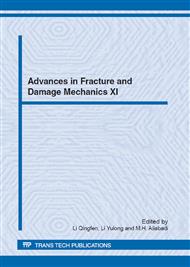[1]
Portela, A., Aliabadi, M.H., Rooke, D.P., Computer and Structures, 46 (2), 237-247, (1993).
Google Scholar
[2]
Portela, A., Aliabadi, M.H., Rooke, D. P INTERNATIONAL JOURNAL FOR NUMERICAL METHODS IN ENGINEERING Vol33 Issue: 6 P 1269-1287, (1992).
Google Scholar
[3]
Aliabadi, M.H., The boundary element method: Applications in solids and structures, John Wiley & Sons, Ltd., West Sussex, England, (2002).
Google Scholar
[4]
Nayroles, B., Touzot, G and Villon, P., 1992. Computational Mechanics 10, 307-318.
DOI: 10.1007/bf00364252
Google Scholar
[5]
Belytschko, T., Lu, Y. Y & Gu, L., 1994. Int. J. Numerical Methods in Engineering 37, 229-256.
Google Scholar
[6]
Wen, P.H. and Aliabadi, M.H., Structural Durability and Health Monitoring, 3 (2), 107-119, (2007).
Google Scholar
[7]
Kim, K and Lee, H., Int. J. Numerical Methods in Engineering 72, 697-721, (2007).
Google Scholar
[8]
Wen PH; Aliabadi MH; Rooke DP, Computer Methods in Applied Mechanics and Engineering, Vol 167 Issue: 1-2 P139-151, (1998).
Google Scholar
[9]
AL Saleh, MH Aliabadi Engineering Fracture Mechanics 51 (4), 533-545, (1995).
Google Scholar
[10]
A Portela, MH Aliabadi, DP International Journal of Fracture 55 (1), 17-28, (1992).
Google Scholar
[11]
P Sollero, MH Aliabadi Composite Structures 31 (3), 229-233, (1995).
Google Scholar
[12]
PH Wen, MH Aliabadi International Journal of Solids and Structures.
Google Scholar
[13]
Fedelinski P; Aliabadi MH; Rooke DP Computers & Structures Vol59 Issue: 6 P (1996).
Google Scholar
[14]
Wen P. H.; Aliabadi M. H.; Lin Y. W. CMES-COMPUTER MODELING IN ENGINEERING & SCIENCES Vol 30 Issue: 3 P 133-147 (2008).
Google Scholar
[15]
Albuquerque EL; Sollero P; Aliabadi MH, International Journal for Numerical Methods in Engineering Vol: 59 Issue: 9 P 1187-1205 (2004).
Google Scholar
[16]
Dirgantara T; Aliabadi MH International Journal of Fracture Vol 105 Issue: 1 P: 27-47, (2000).
Google Scholar
[17]
Sfantos G. K.; Aliabadi M. H. Source: Computer Methods in Applied Mechanics and Engineering, Vol 196 Issue: 7 P 1310-1329 (2007).
DOI: 10.1016/j.cma.2006.09.004
Google Scholar
[18]
Wen P. H.; Aliabadi M. H., Communications in Numerical Methods in Engineering Vol: 24 Issue: 8 P: 635-651 (2008).
Google Scholar


